Evaluation of Water Resources Carrying Capacity and Its Obstruction Factor Analysis: A Case Study of Hubei Province, China
Abstract
1. Introduction
- (1)
- The composition indicators of the water resources carrying capacity calculation system in the developed areas of reservoir construction were updated.
- (2)
- The theory was verified using the Dematel method, with the results showing that the hypothesis is feasible.
- (3)
- The water resources carrying capacity of Hubei province was calculated using the cloud model with the hope to provide references for local economic development and construction. Following this, the obstacle degree was added to identify the factors with the greatest influence on the water resources carrying capacity.
2. Research Area and Analysis Methods
2.1. Research Area
2.2. Analysis Methods
2.2.1. The Centrality of Each Indicator Was Verified Using the Dematel Method
- (1)
- Count each indicator as , , …, , ,
- (2)
- Analyze the correlation between indicators according to existing data results and relevant research experience, and construct a straight line between the indicators according to the obtained results. Then, the influence matrix A was used to mark the direct influence degree of each index using the “0/1 scale method”.was used to indicate the degree of direct influence between the indicators. When there was a direct influence, was equal to 1, and when there was no direct influence, it was equal to 0.
- (3)
- According to the three types of system calculations, as shown in Table 1, matrix A was standardized to establish a comprehensive influence matrix. Then, influence degree of each index, affected degree , central degree , and cause degree were calculated.
2.2.2. Using the Cloud Model Method to Calculate Water Resources Carrying Capacity in Hubei Province
2.2.3. Introducing the Concept of Obstacle Degree to Identify Water Resources Carrying Capacity
3. Data and Results Analysis
4. Discussion and Conclusions
- (1)
- The calculation of the water resources carrying capacity evaluation system was updated. had an influence degree of 1.3483, an affected degree of 0.3964, a center degree of 1.7447, and a cause degree of 0.9519. This indicated that the reservoir water volume should be considered as an important factor affecting other indexes in the evaluation of water resources carrying capacity in developed areas of reservoir construction proposed in this paper. The regulating function of reservoirs should be strengthened in future water resource management to better distribute water resources.
- (2)
- According to expert opinions and analyses of the existing results, the weight of each index was determined reasonably. The fuzzy and deterministic relationships between the evaluation indexes was solved using the cloud model, which made the water resources carrying capacity calculation more reliable.
- (3)
- The water resources carrying capacity in Hubei province is generally developing steadily. The transformation of the water resources protection policy presented by the government in the beginning of the century (such as the State Council of China’s opinions on the implementation of strict water resource management systems), has been very effective. The Chinese society no longer trades in the environment for rapid economic development.
- (4)
- The amount of water per unit area is the main factor restricting the water resources carrying capacity of Hubei province. The obstacle degree has been high for many years, reaching 19.24%. Rainfall and population density are also important factors that restrict the carrying capacity of water resources. The average annual obstacle degree reached 13.27% and 13.62%. Furthermore, the obstacle degree of reservoir water storage capacity for water resources has been 5.44% for many years. According to the evaluation system proposed in this paper, this is at the intermediate level, indicating that reservoir water storage is also an important factor that cannot be ignored. Among the subsystems outlined in this paper, the natural resource system had the strongest inhibition on the water resources carrying capacity of Hubei province, indicating that the natural resources in Hubei province could not meet the needs of the rapid development of the socio-economic environment in the country; therefore, more efficient utilization measures are needed.
Author Contributions
Funding
Conflicts of Interest
References
- Qin, G.; Li, H.; Wang, X.; Ding, J. Research on Water Resources Design Carrying Capacity. Water 2016, 8, 157. [Google Scholar] [CrossRef]
- Xu, Y.P. A study of comprehensive evaluation of the water resource carrying capacity in the arid area—A case study in the Hetian river basin of Xinjiang. J. Nat. Resour. 1993, 3, 229–237. [Google Scholar]
- Berger, A.R.; Hodge, R.A. Natural Change in the Environment: A Challenge to the Pressure-State-Response Concept. Soc. Indic. Res. 1998, 44, 255–265. [Google Scholar] [CrossRef]
- Zhang, J.; Zhang, C.; Shi, W.; Fu, Y. Quantitative evaluation and optimized utilization of water resources-water environment carrying capacity based on nature-based solutions. J. Hydrol. 2019, 568, 96–107. [Google Scholar] [CrossRef]
- Cheng, K.; Fu, Q.; Meng, J.; Li, T.X.; Pei, W. Analysis of the spatial variation and identification of factors affecting the water resources carrying capacity based on the cloud model. Water Resour. Manag. 2018, 32, 2767–2781. [Google Scholar] [CrossRef]
- Ren, C.; Guo, P.; Li, M.; Li, R. An innovative method for water resources carrying capacity research—Metabolic theory of regional water resources. J. Environ. Manag. 2016, 167, 139–146. [Google Scholar] [CrossRef]
- Wang, C.; Hou, Y.; Xue, Y. Water resources carrying capacity of wetlands in Beijing: Analysis of policy optimization for urban wetland water resources management. J. Clean. Prod. 2017, 161, 1180–1191. [Google Scholar] [CrossRef]
- Song, X.M.; Kong, F.Z.; Zhan, C.S. Assessment of Water Resources Carrying Capacity in Tianjin City of China. Water Resour. Manag. 2011, 25, 857–873. [Google Scholar] [CrossRef]
- Kijewska, K.; Torbacki, W.; Iwan, S. Application of AHP and DEMATEL Methods in Choosing and Analysing the Measures for the Distribution of Goods in Szczecin Region. Sustainability 2018, 10, 2365. [Google Scholar] [CrossRef]
- Govindan, K.; Kannan, D.; Shankar, K.M. Evaluating the drivers of corporate social responsibility in the mining industry with multi-criteria approach: A multi-stakeholder perspective. J. Clean. Prod. 2014, 84, 214–232. [Google Scholar] [CrossRef]
- Saaty, T.L. Fundamentals of Decision Making and Priority Theory with the Analytic Hierarchy Process; RWS Publications: Pittsburgh, PA, USA, 2000. [Google Scholar]
- Wang, G.; Xu, C.; Li, D. Generic normal cloud model. Inf. Sci. 2014, 280, 1–15. [Google Scholar] [CrossRef]
- Gupta, H.; Barua, M.K. A grey DEMATEL-based approach for modeling enablers of green innovation in manufacturing organizations. Environ. Sci. Pollut. Res. 2018, 25, 9556–9578. [Google Scholar] [CrossRef] [PubMed]
- Lee, H.S.; Tzeng, G.H.; Yeih, W. Revised DEMATEL: Resolving the infeasibility of DEMATEL. Appl. Math. Model. 2013, 37, 6746–6757. [Google Scholar] [CrossRef]
- Cui, Y.; Feng, P.; Jin, J.; Liu, L. Water resources carrying capacity evaluation and diagnosis based on set pair analysis and improved the entropy weight method. Entropy 2018, 20, 359. [Google Scholar] [CrossRef]
- Zhou, X.; Lei, G.; Xu, S. An Evaluation of Urban Land Use Performance and Diagnosis of Its Obstacle Degree—A Case Study of Harbin City. Res. Soil Water Conserv. 2012, 2, 126–130. [Google Scholar]
- Guo, M.; Bu, Y.; Cheng, J.; Jiang, Z. Natural Gas Security in China: A Simulation of Evolutionary Trajectory and Obstacle Degree Analysis. Sustainability 2018, 11, 96. [Google Scholar] [CrossRef]
- Wanders, N.; Wada, Y. Human and climate impacts on the 21st century hydrological drought. J. Hydrol. 2015, 526, 208–220. [Google Scholar] [CrossRef]
- Wang, M.; Du, L.; Ke, Y. Impact of Climate Variabilities and Human Activities on Surface Water Extents in Reservoirs of Yongding River Basin, China, from 1985 to 2016 Based on Landsat Observations and Time Series Analysis. Remote Sens. 2019, 11, 560. [Google Scholar] [CrossRef]
- Liu, Y.; Qin, H.; Mo, L.; Wang, Y.; Chen, D.; Pang, S.; Yin, X. Hierarchical flood operation rules optimization using multi-objective cultured evolutionary algorithm based on decomposition. Water Resour. Manag. 2019, 33, 337–354. [Google Scholar] [CrossRef]
- Balzannikov, M.I.; Vyshkin, E.G. Hydroelectric power plants reservoirs and their impact on the environment. In Proceedings of the 8-th International Scientific and Practical Conference, Rezekne, Latvia, 20–22 June 2011; Volume 1, pp. 171–174. [Google Scholar]
- Degu, A.M.; Hossain, F.; Niyogi, D.; Pielke Sr, R.; Shepherd, J.M.; Voisin, N.; Chronis, T. The influence of large dams on surrounding climate and precipitation patterns. Geophys. Res. Lett. 2011, 38. [Google Scholar] [CrossRef]
- Zhang, Q.; Lou, Z. The environmental changes and mitigation actions in the Three Gorges Reservoir region, China. Environ. Sci. Policy 2011, 14, 1132–1138. [Google Scholar] [CrossRef]
- Stone, R. Three Gorges Dam: Into the Unknown. Science 2008, 321, 628–632. [Google Scholar] [CrossRef] [PubMed]
- Liu, Y.; Ye, L.; Qin, H.; Hong, X.; Ye, J.; Yin, X. Monthly streamflow forecasting based on Hidden Markov Model and Gaussian Mixture Regression. J. Hydrol. 2018, 561, 146–159. [Google Scholar] [CrossRef]
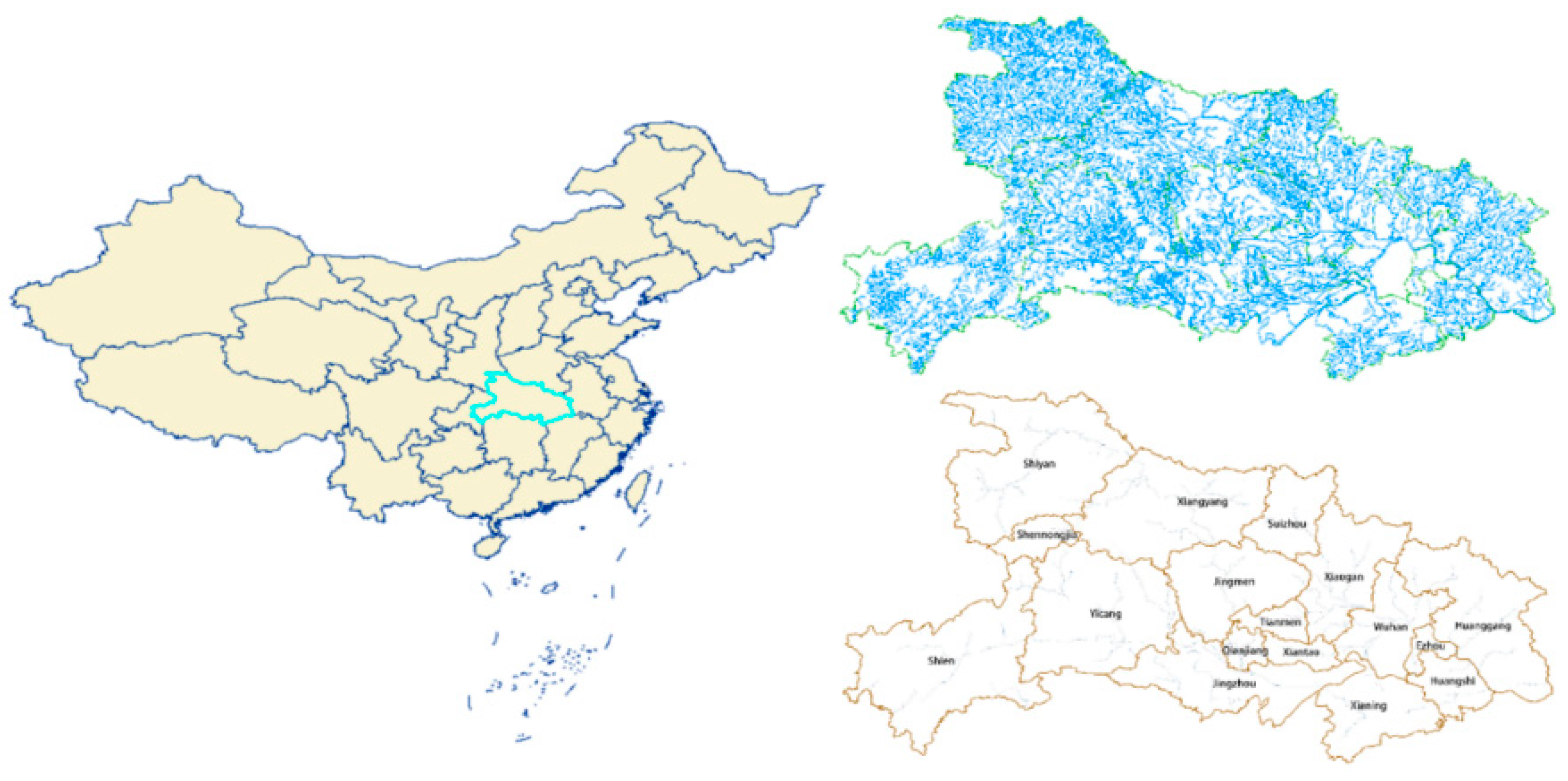
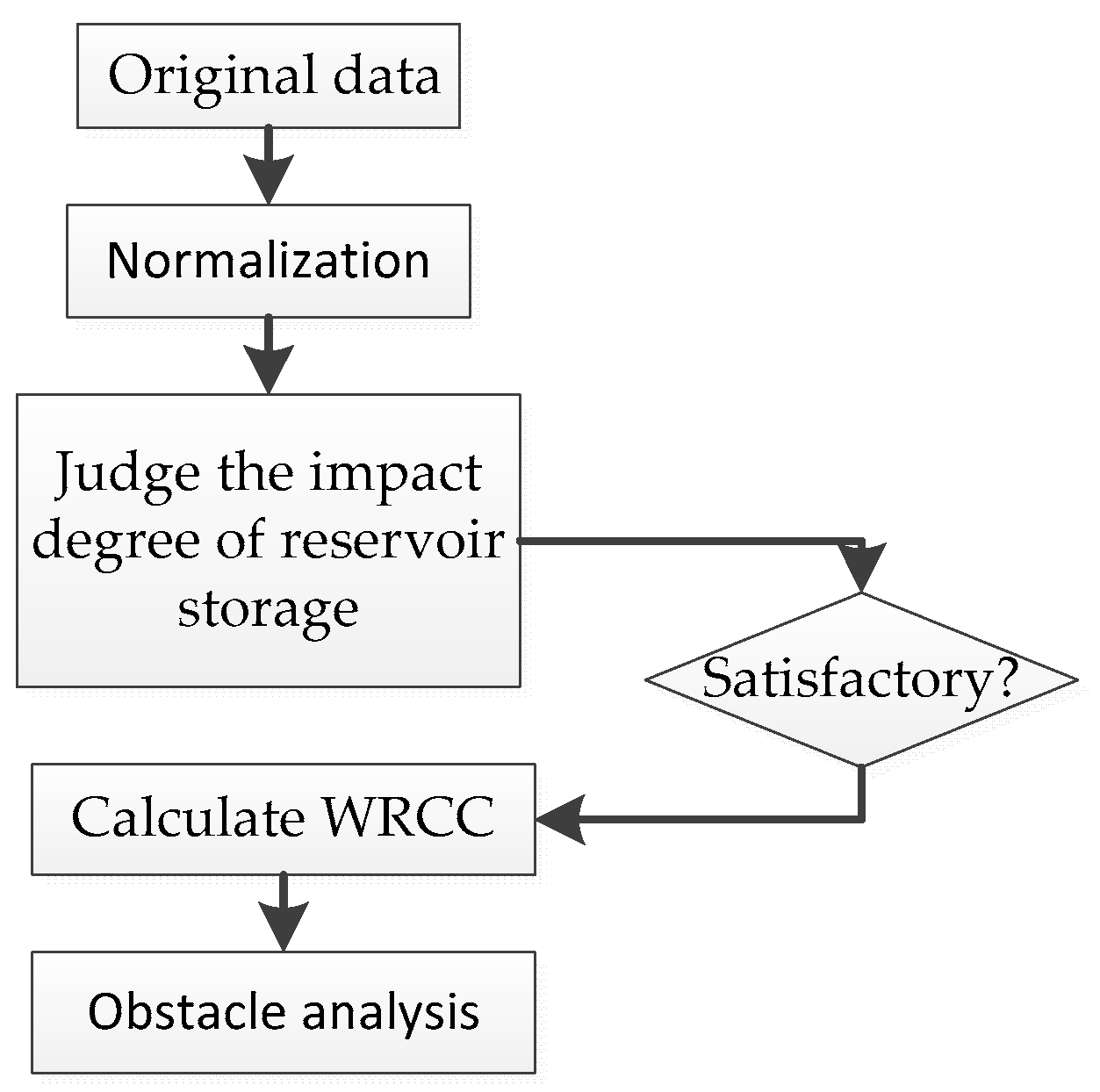
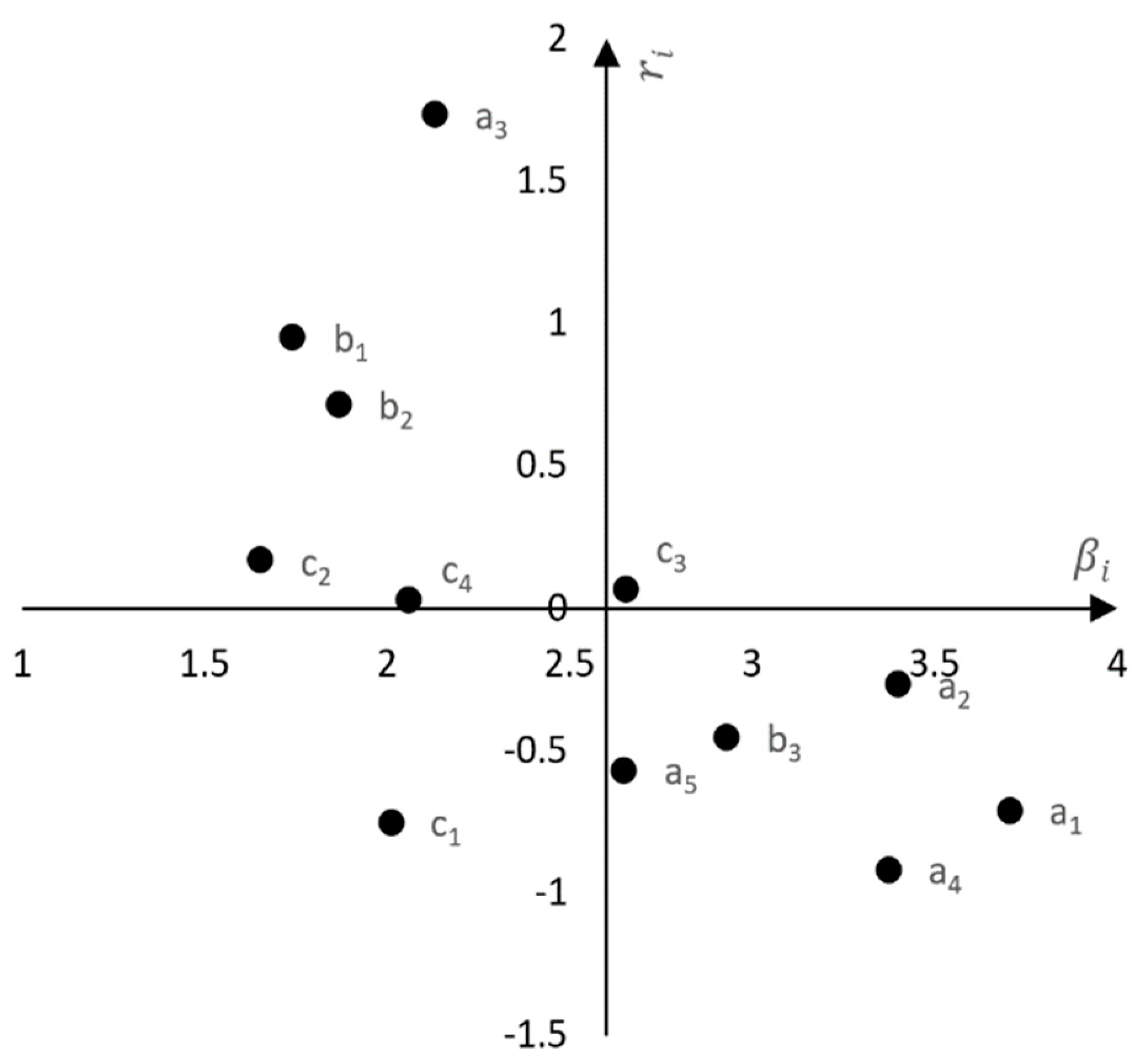
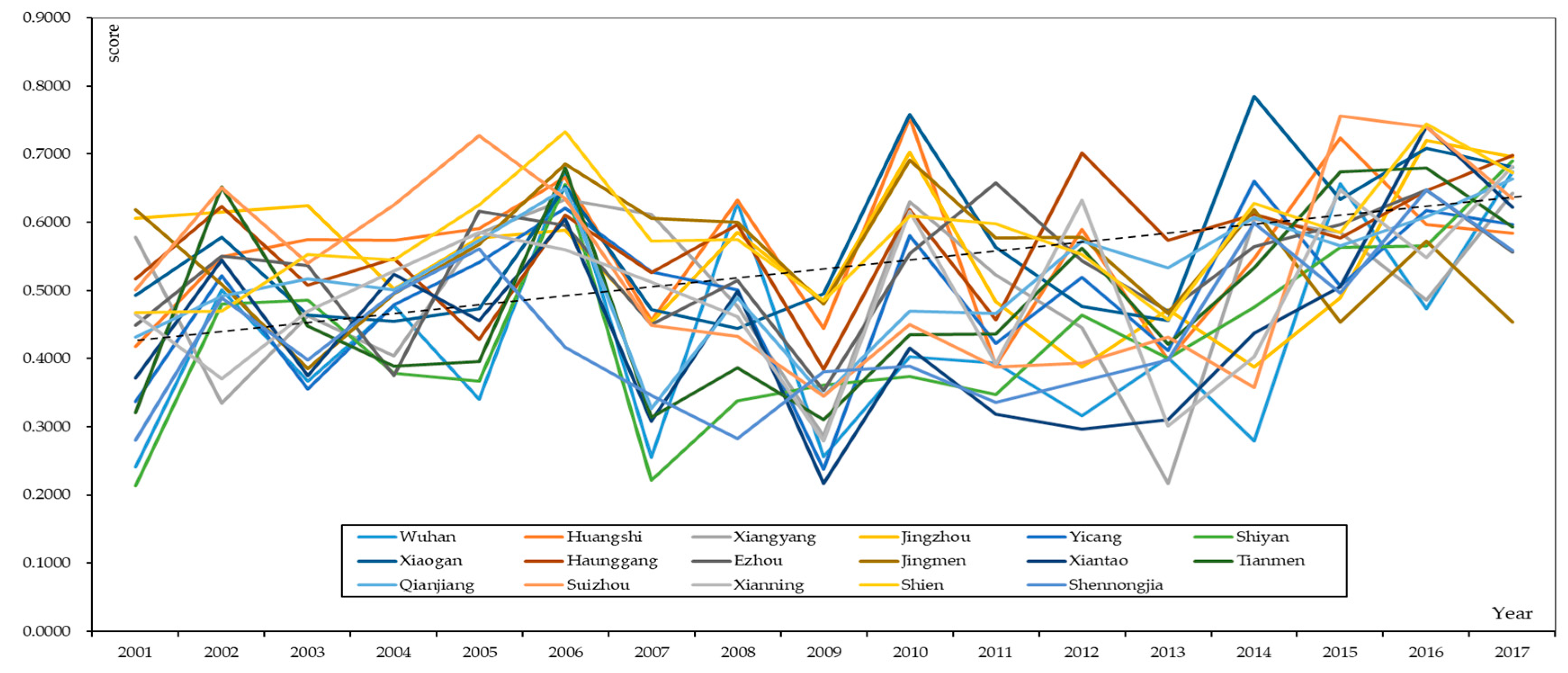
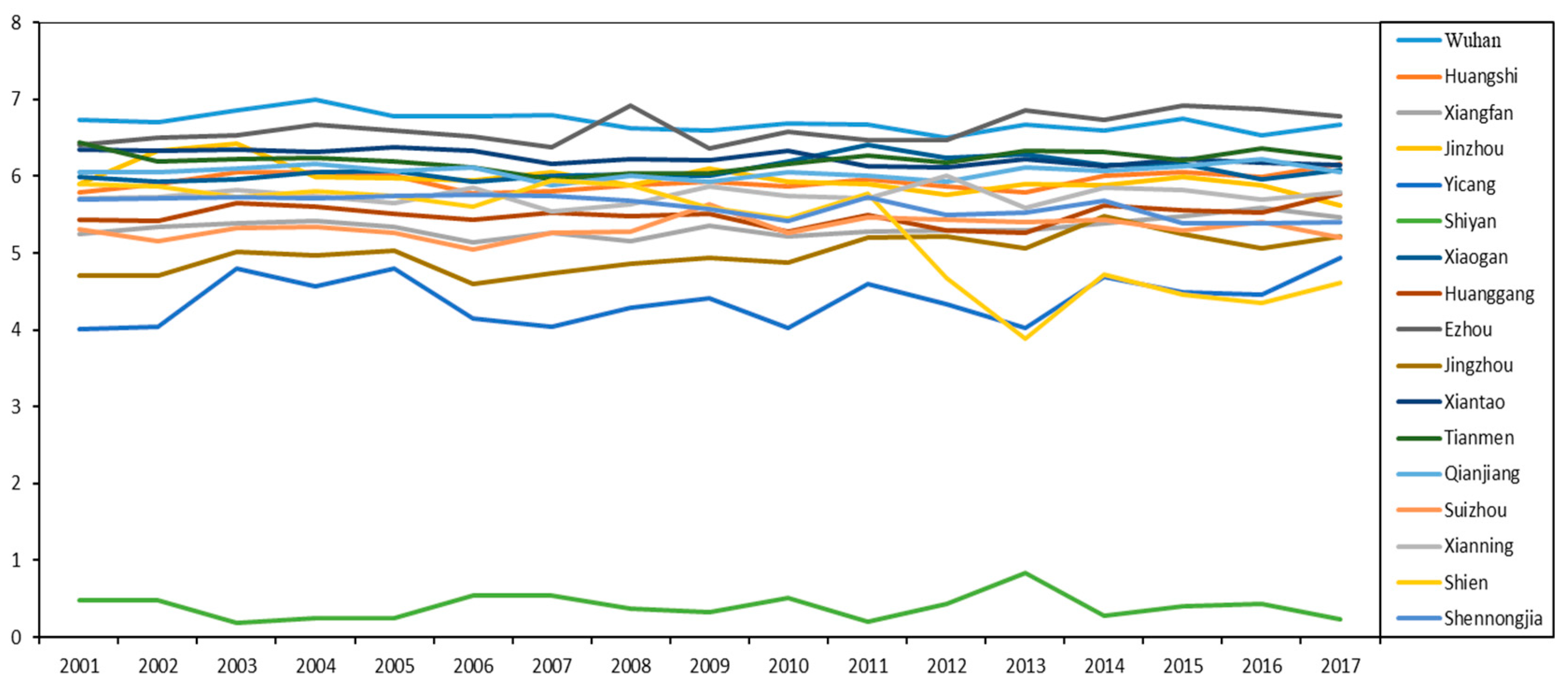
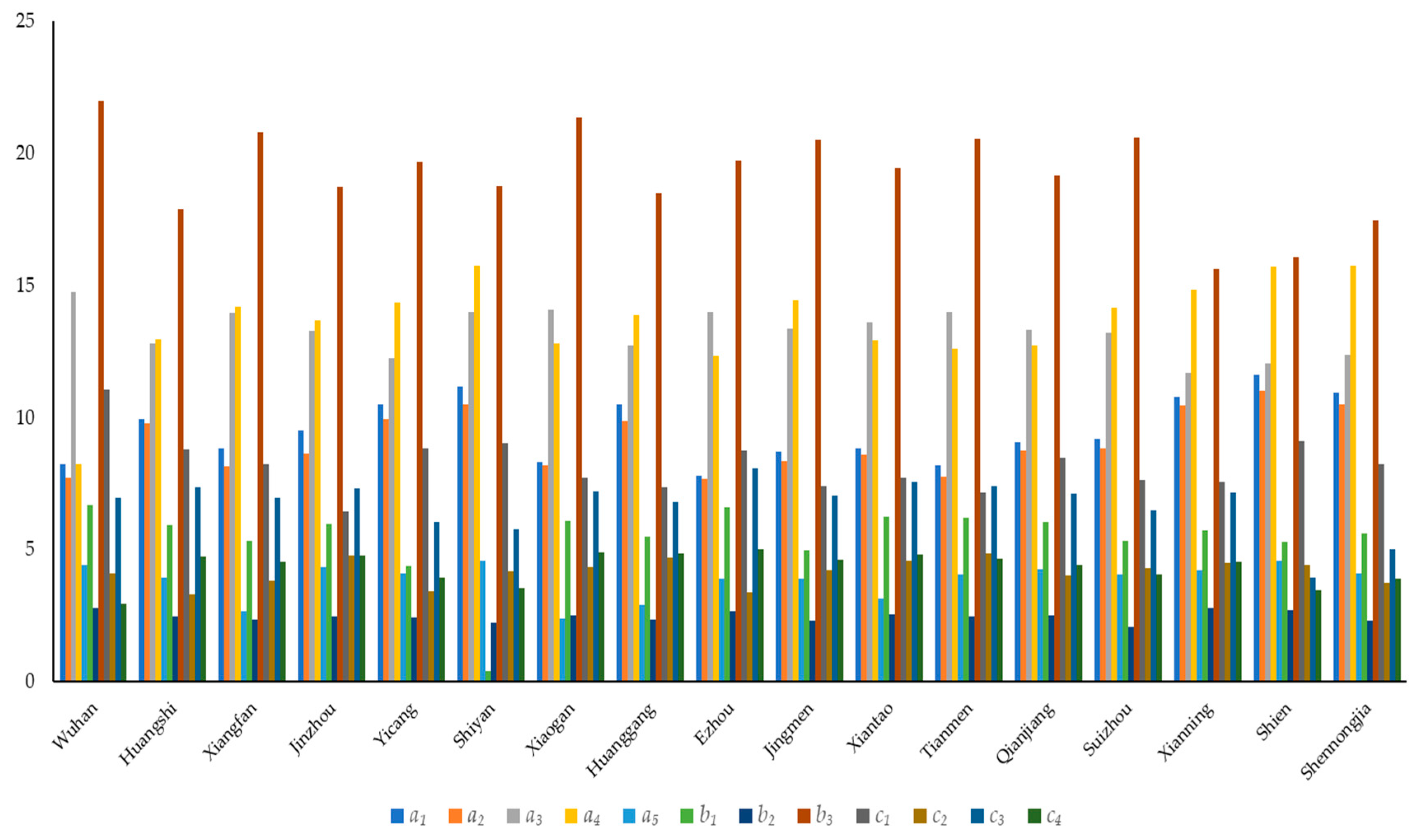
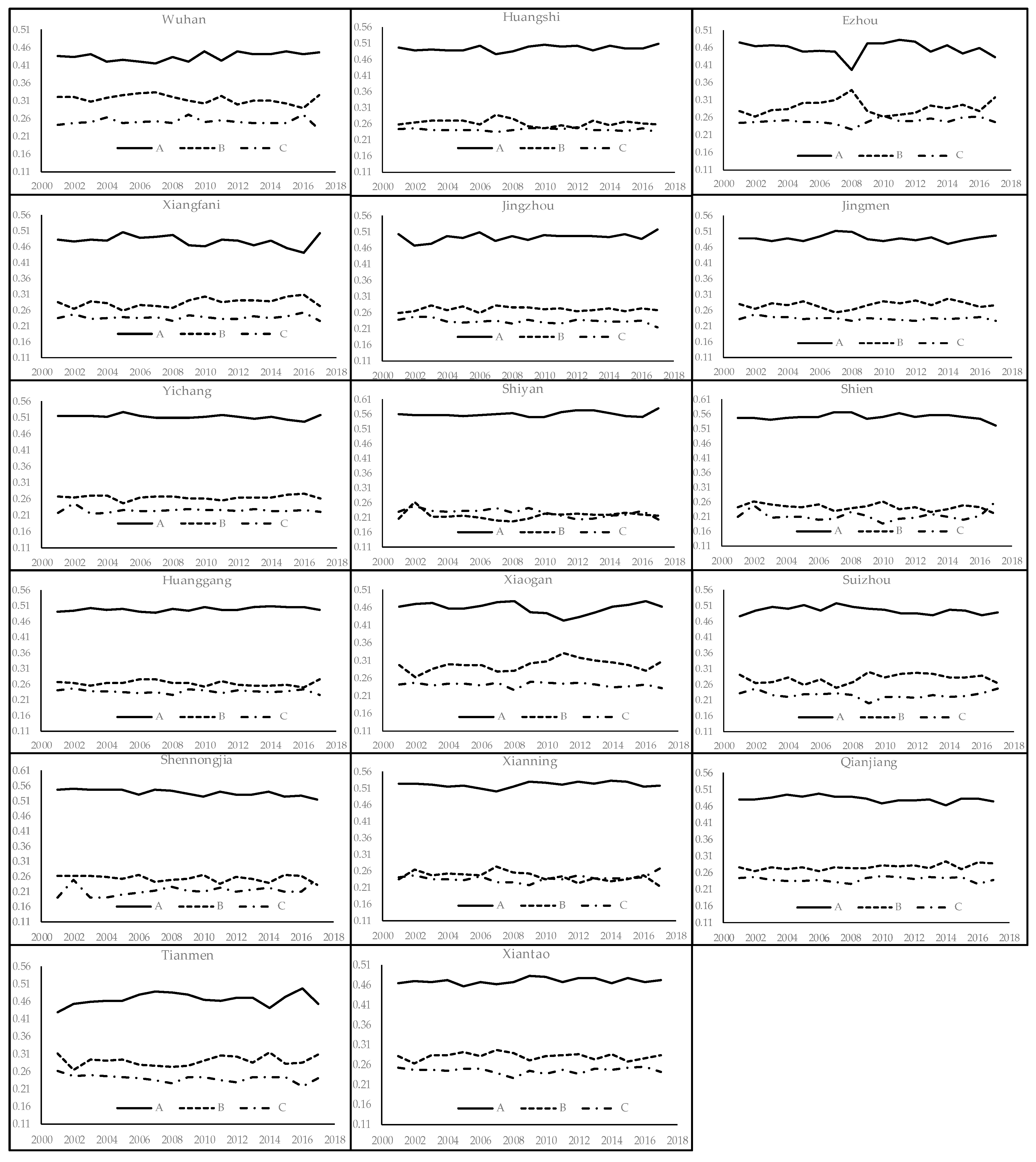
| System | Indicators |
|---|---|
| Resource system (A) | Water resource utilization rate (%) |
| Surface water utilization (%) | |
| Precipitation (mm) | |
| Population density (person/km2) | |
| Groundwater utilization rate (%) | |
| Water quantity and efficiency system (B) | Storage of reservoir (108 m3) |
| Average water consumption per mu of farmland (m3) | |
| Water resources per unit area (m3/km2) | |
| Socio-economic system (C) | 10,000 yuan of GDP water consumption (m3) |
| Industrial water consumption (%) | |
| Domestic water consumption (%) | |
| Ecological water consumption (%) |
| Wuhan | Huangshi | Xiangfan | Jinzhou | Yicang | Shiyan | Xiaogan | Huanggang | Ezhou | Jingzhou | Xiantao | Tianmen | Qianjiang | Suizhou | Xianning | Shien | Shennongjia | |
|---|---|---|---|---|---|---|---|---|---|---|---|---|---|---|---|---|---|
| 2001 | 4.91 | 35.59 | 27.05 | 4.59 | 33.10 | 194.87 | 7.06 | 13.59 | 0.33 | 81.00 | ╲ | ╲ | ╲ | 70.58 | 9.65 | 1.11 | ╲ |
| 2002 | 5.41 | 23.86 | 21.30 | 2.23 | 20.33 | 160.03 | 8.24 | 8.07 | 0.26 | 55.65 | ╲ | ╲ | ╲ | 26.78 | 6.02 | 1.07 | ╲ |
| 2003 | 5.45 | 22.33 | 20.62 | 193 | 18.51 | 156.47 | 8.35 | 7.55 | 0.25 | 52.43 | ╲ | ╲ | ╲ | 24.64 | 5.53 | 1.06 | ╲ |
| 2004 | 7.26 | 27.74 | 22.86 | 3.88 | 27.94 | 201.19 | 13.28 | 11.66 | 0.36 | 53.14 | ╲ | ╲ | ╲ | 45.70 | 8.78 | 1.09 | ╲ |
| 2005 | 10.76 | 29.81 | 17.49 | 3.78 | 29.14 | 115.59 | 13.75 | 14.32 | 0.79 | 82.04 | ╲ | ╲ | ╲ | 32.33 | 13.72 | 2.91 | ╲ |
| 2006 | 9.12 | 36.37 | 28.23 | 3.62 | 31.96 | 163.68 | 18.08 | 16.58 | 0.56 | 68.68 | ╲ | ╲ | ╲ | 65.28 | 11.71 | 4.59 | ╲ |
| 2007 | 9.03 | 41.15 | 19.85 | 4.51 | 26.09 | 160.90 | 9.05 | 14.79 | 0.53 | 35.78 | ╲ | ╲ | ╲ | 21.45 | 14.42 | 2.71 | 0.29 |
| 2008 | 10.44 | 37.55 | 24.46 | 4.66 | 26.82 | 214.83 | 8.84 | 15.14 | 0.56 | 42.58 | ╲ | ╲ | ╲ | 30.75 | 11.82 | 3.27 | 0.85 |
| 2009 | 7.28 | 27.12 | 29.48 | 4.17 | 29.64 | 159.77 | 23.52 | 14.70 | 0.35 | 59.20 | ╲ | ╲ | ╲ | 41.51 | 9.95 | 4.22 | 1.07 |
| 2010 | 5.26 | 20.98 | 33.18 | 2.95 | 30.20 | 116.64 | 9.47 | 10.52 | 0.10 | 56.80 | ╲ | ╲ | ╲ | 31.61 | 7.03 | 5.15 | 0.88 |
| 2011 | 10.65 | 29.44 | 40.02 | 5.31 | 42.99 | 209.60 | 14.87 | 20.16 | 0.31 | 66.64 | ╲ | ╲ | ╲ | 62.96 | 12.30 | 5.85 | 1.13 |
| 2012 | 8.84 | 36.47 | 34.26 | 5.39 | 38.40 | 222.02 | 9.00 | 17.75 | 0.28 | 70.13 | ╲ | ╲ | ╲ | 62.15 | 9.96 | 21.45 | 0.56 |
| 2013 | 9.27 | 35.12 | 33.67 | 5.48 | 34.74 | 191.96 | 6.93 | 17.57 | 0.22 | 43.60 | ╲ | ╲ | ╲ | 46.53 | 11.41 | 26.67 | 0.55 |
| 2014 | 9.80 | 32.55 | 37.82 | 6.64 | 39.74 | 279.33 | 8.04 | 16.21 | 0.46 | 66.27 | ╲ | ╲ | ╲ | 32.01 | 11.08 | 27.84 | 0.90 |
| 2015 | 7.11 | 28.63 | 40.26 | 3.51 | 37.03 | 285.29 | 7.70 | 13.65 | 0.31 | 46.17 | ╲ | ╲ | ╲ | 44.30 | 8.15 | 29.00 | 1.17 |
| 2016 | 4.38 | 22.14 | 33.34 | 3.10 | 23.56 | 297.47 | 6.30 | 9.70 | 0.13 | 31.30 | ╲ | ╲ | 15.73 | 30.22 | 6.86 | 20.47 | 0.39 |
| 2017 | 9.98 | 26.80 | 23.76 | 4.65 | 25.79 | 225.54 | 14.47 | 15.69 | 0.54 | 52.87 | ╲ | ╲ | 24.50 | 35.09 | 5.90 | 21.91 | 0.69 |
| 1.4995 | 2.2062 | 3.7057 | −0.7067 | |
| 1.5667 | 1.8331 | 3.3998 | −0.2664 | |
| 1.9322 | 0.1996 | 2.1318 | 1.7326 | |
| 1.2281 | 2.1462 | 3.3743 | −0.9181 | |
| 1.0416 | 1.6091 | 2.6507 | −0.5675 | |
| 1.3483 | 0.3964 | 1.7447 | 0.9519 | |
| 1.2915 | 0.5759 | 1.8674 | 0.7156 | |
| 1.2388 | 1.6927 | 2.9315 | −0.4539 | |
| 0.6296 | 1.3812 | 2.0108 | −0.7516 | |
| 0.9095 | 0.7447 | 1.6542 | 0.1648 | |
| 1.3615 | 1.2918 | 2.6533 | 0.0697 | |
| 1.0433 | 1.0137 | 2.0570 | 0.0296 |
| Indicators | Extremely Dangerous | Dangerous | Normal | Safe | Very Safe |
|---|---|---|---|---|---|
| Water resource utilization rate (%) | >90 | 60–90 | 50–60 | 40–50 | <40 |
| Surface water utilization (%) | >80 | 60–80 | 45–60 | 45–30 | <30 |
| Precipitation (mm) | <88 | 88–607 | 607–1126 | 1126–1607 | >2087 |
| Population density (person/km2) | >600 | 500–600 | 200–600 | 100–200 | <10 |
| Groundwater utilization rate (%) | >85 | 60–85 | 50–60 | 30–60 | <30 |
| Storage of reservoir (108 m3) | <3 | 3–10 | 10–20 | 20–30 | >30 |
| water consumption per mu of farmland (m3) | >500 | 450–350 | 250–350 | 250–150 | >150 |
| Water resources per unit area (m3/km2) | <310,000 | 310,000–545,000 | 545,000–740,000 | 740,000–890,000 | >890,000 |
| 10,000 yuan of GDP water consumption (m3) | >500 | 500–400 | 400–300 | 300–200 | 200–100 |
| Industrial water consumption (%) | >60 | 45–60 | 35–45 | 25–35 | <25 |
| Domestic water consumption (%) | >25 | 20–25 | 15–20 | 10–15 | >5 |
| Ecological water consumption (%) | >50 | 50–40 | 30–20 | 20–10 | >10 |
© 2019 by the authors. Licensee MDPI, Basel, Switzerland. This article is an open access article distributed under the terms and conditions of the Creative Commons Attribution (CC BY) license (http://creativecommons.org/licenses/by/4.0/).
Share and Cite
Zhu, L.; Li, X.; Bai, Y.; Yi, T.; Yao, L. Evaluation of Water Resources Carrying Capacity and Its Obstruction Factor Analysis: A Case Study of Hubei Province, China. Water 2019, 11, 2573. https://doi.org/10.3390/w11122573
Zhu L, Li X, Bai Y, Yi T, Yao L. Evaluation of Water Resources Carrying Capacity and Its Obstruction Factor Analysis: A Case Study of Hubei Province, China. Water. 2019; 11(12):2573. https://doi.org/10.3390/w11122573
Chicago/Turabian StyleZhu, Longjun, Xinchen Li, Yiran Bai, Tailai Yi, and Liqiang Yao. 2019. "Evaluation of Water Resources Carrying Capacity and Its Obstruction Factor Analysis: A Case Study of Hubei Province, China" Water 11, no. 12: 2573. https://doi.org/10.3390/w11122573
APA StyleZhu, L., Li, X., Bai, Y., Yi, T., & Yao, L. (2019). Evaluation of Water Resources Carrying Capacity and Its Obstruction Factor Analysis: A Case Study of Hubei Province, China. Water, 11(12), 2573. https://doi.org/10.3390/w11122573




